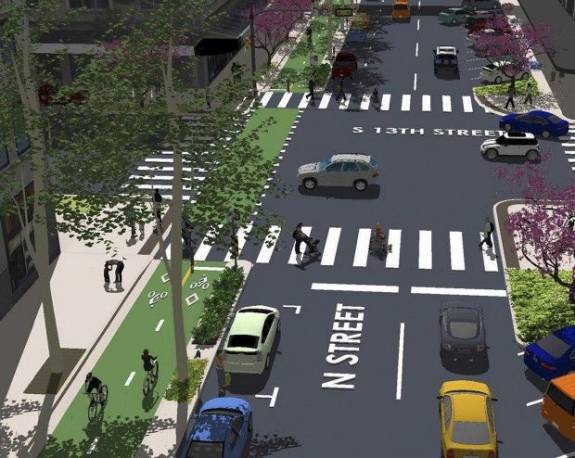The city of Lincoln, Nebraska is proposing the creation of a two-way protected bikeway in downtown, which would be among the first in our region.
The bikeway would be a section of the roadway, located between the sidewalk and parked cars or shared traffic lanes, separated from vehicles by a raised median containing landscaping, with a single lane going each direction within the bikeway. The bikeway will be painted bright green to provide visual cues to both bicyclists, pedestrians, and motorists.
Here is a rendering of one possible configuration:

(Illustration courtesy Crandall Arambula PC.)
The purpose of the bikeway is “to provide a safe connection through downtown between the Billy Wolff Trail and the Jamaica North Trail”, completing a missing link in the Lincoln trail network.
The protected bikeway concept was approved as part of the Downtown Master Plan Update in 2012. The design still needs to be finalized, and needs city council approval. If all goes according to plan, construction could begin this fall.
The city selected Alta Planning & Design and Olsson Associates to develop concepts, a master plan, and design and construction documents for the “N” Street protected bikeway.
Protected bikeways are also called “Cycle Tracks”. The National Association of City Transportation Officials (NACTO) describes the concept as part of their Urban Bikeway Design Guide:
A cycle track is an exclusive bike facility that combines the user experience of a separated path with the on-street infrastructure of a conventional bike lane. A cycle track is physically separated from motor traffic and distinct from the sidewalk. Cycle tracks have different forms but all share common elements—they provide space that is intended to be exclusively or primarily used for bicycles, and are separated from motor vehicle travel lanes, parking lanes, and sidewalks. By separating cyclists from motor traffic, cycle tracks can offer a higher level of security than bike lanes and are attractive to a wider spectrum of the public.
A study from the Rails to Trails Conservancy, Better Bikeways, says:
Cycle tracks are best suited for high-volume streets in downtowns and busy neighborhood thoroughfares where heavy traffic creates a daunting environment for bicycling. Cycle tracks perform best where motor vehicle turns are limited and the path is not crossed by multiple driveways. For cities with a commitment to more livable, healthy and active communities, cycle tracks can be part of an overall strategy to increase bicycle usage.
The study does a good job of detailing the advantages and disadvantages of this type of facility
Wikipedia offers some additional history and discussion of cycle tracks and protected bikeways.
See local coverage from Lincoln:
— Lincoln’s First Protected Bikeway
— Bicyclists line up in support of downtown plan
— Council hears conflicting views on protected bike lane
— Mixed thoughts on N Street bikeways
— N Street bikeway plan has legs
— Proposed Bike Path Could Mean Loss of Parking Downtown
— ‘Protected’ bike lane not safer
Most of the community response for the plan appears to be positive, though there is some divergence of opinion, among both cyclists and the general public. Experience in other cities seems to bear out safety improvements (Dedicated Bike Lanes Can Cut Cycling Injuries in Half, The Debate About Bike Infrastructure Has Been Settled) and positive economic impacts (NYC Study Finds Protected Bicycle Lanes Boost Local Business, Bike Lanes Offer Growth to Businesses, Safety & Savings to Consumers).
A major study, Lessons from the Green Lane, a Comprehensive Evaluation of Protected Cycling Facilities, is currently in progress in Oregon “to examine ridership, safety, and the economic impact of green lanes in six major U.S. cities”.
Obviously, the details are critical in any design, especially at intersections, and particularly when introducing a new concept to a community. And there are an incredible number of details when adding infrastructure to a complex downtown environment. Let’s hope the planners, engineers, and builders get it right in Lincoln!
Post tags: Bike Lanes



Looks workable as long as the adjacent street never becomes two way or switches direction.
Yet another Midwest city that is leaving Kansas City, and particularly Kansas City, Kansas in its dust. We are getting left behind not only nationally but regionally in making our city more livable and attractive.
For clarification: Crandall Arambula PC developed the concept for the N Street Protected Bikeway as a product of the the Downtown Master Plan. Please credit the photo to our firm.
Alta and Olsson are providing design refinement and construction documents for the Downtown Master Plan concept
Done. Thanks, Don!